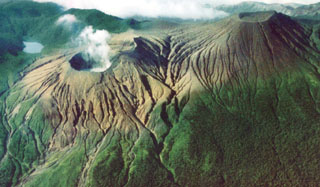Report on Rincon de la Vieja (Costa Rica) — March 1998
Bulletin of the Global Volcanism Network, vol. 23, no. 3 (March 1998)
Managing Editor: Richard Wunderman.
Rincon de la Vieja (Costa Rica) Phreatic eruptions on 15-17 February thrust steam to 2 km
Please cite this report as:
Global Volcanism Program, 1998. Report on Rincon de la Vieja (Costa Rica) (Wunderman, R., ed.). Bulletin of the Global Volcanism Network, 23:3. Smithsonian Institution. https://doi.org/10.5479/si.GVP.BGVN199803-345020
Rincon de la Vieja
Costa Rica
10.83°N, 85.324°W; summit elev. 1916 m
All times are local (unless otherwise noted)
Beginning at 1428 on 15 February, Rincón de la Vieja volcano discharged phreatic eruptions from the main crater. Ten eruptions took place in the first 15 hours of activity; only two followed in the subsequent 13 hours. During the course of the outburst subsidiary fumarolic activity also became more vigorous; it remained elevated until 18 February.
During 15-17 February numerous steam plumes rose hundreds of meters above the volcano. On 17 February one outburst sent a steam plume to a height of 2 km above the crater. This plume was seen by residents on the N and NE flanks of the volcano. A dozen eruptions around this time were small and lacked associated mudflows. An exception, at 0514 on 16 February, produced a modest mudflow that traveled about 9 km/hour and left a capping deposit of mud 30-cm thick in the upper reaches of the Pénjamo and Azul rivers. Rivers had been low in the region, attributed to the El Niño phenomena, with the result that the mudflow was relatively dry. The mudflow had a large impact on local fish and other stream organisms. Sediment from the mudflow was found 12.3 km from the main crater.
Inspecting the 16 February deposit near the summit on 1 March, scientists inferred from the scorching, burning, and other damage to vegetation on the NE flanks that there must have been several smaller eruptions around that time as well. Mudflows failed to develop due to the paucity of surface water in local drainages.
The 1 March visit also revealed the lake's temperature, 48°C, its color, light gray, the presence of suspended sulfur in the lake, and a haze of condensed gases above the lake. An outgassing fumarole on the SW wall made loud hissing noises (similar to gases exiting a high pressure valve) audible from the crater's rim. Columns of gas rose about 200 m above the crater before being blown E. Those inspecting the scene noted strong sulfurous odors, and experienced irritated skin and eyes. The material erupted was uniformly fine- to medium-grained, lacking either bombs, blocks, or impact craters. This contrasted with deposits left by previous eruptions in 1991 and 1995.
The local seismic station (RIN3) lies 5 km SW of the active crater. The station registered microearthquakes as follows: during January, 18 (including 3 of high frequency and 9 of low frequency); during February, 48 (including 1 of high frequency, 21 of low frequency); during March, 7. In assessing their records of the 48 February microearthquakes, seismologists recognized 20 eruptions including 11 comparatively high-intensity phreatic eruptions mainly registered on 15-18 February. Banded tremor occurred on 15 and 16 February during the main eruptive interval; the tremor prevailed for a total of ~6.5 hours. Low in frequency, the tremor had amplitudes that ranged between 1.0 and 37 mm. The larger amplitude registered during the eruption's initial phase, at 1428 on 15 February. Tremor amplitudes later declined to the 1-4 mm range. As with the 1991 and 1995 eruptions, seismic precursors were absent.
Geological Summary. Rincón de la Vieja, the largest volcano in NW Costa Rica, is a remote volcanic complex in the Guanacaste Range. The volcano consists of an elongated, arcuate NW-SE-trending ridge constructed within the 15-km-wide early Pleistocene Guachipelín caldera, whose rim is exposed on the south side. Sometimes known as the "Colossus of Guanacaste," it has an estimated volume of 130 km3 and contains at least nine major eruptive centers. Activity has migrated to the SE, where the youngest-looking craters are located. The twin cone of Santa María volcano, the highest peak of the complex, is located at the eastern end of a smaller, 5-km-wide caldera and has a 500-m-wide crater. A Plinian eruption producing the 0.25 km3 Río Blanca tephra about 3,500 years ago was the last major magmatic eruption. All subsequent eruptions, including numerous historical eruptions possibly dating back to the 16th century, have been from the prominent active crater containing a 500-m-wide acid lake located ENE of Von Seebach crater.
Information Contacts: E. Fernandez, V. Barboza, R. Van der Laat, R. Sáenz, E. Duarte, E. Malavassi, T. Marino, M. Martinez, and E. Hernandez, Observatorio Vulcanológico y Sismológico de Costa Rica, Universidad Nacional (OVSICORI-UNA), Apartado 86-3000, Heredia, Costa Rica; Mauricio Mora Fernandez, Sección de Sismologia, Vulcanologia y Exploración Geofisica, Escuela Centroamericana de Geología, Universidad de Costa Rica, P.O. Box 35-2060, San José, Costa Rica.

